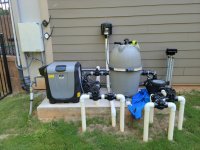Greetings homie. I've kept ours open 2 winters here in Chapel Hill. Also with Aqualink equipment.
Spend some time with the Aqualink manual. You want to be familiar. There's a setting for the freeze protect turn-on temp. It goes down to 34. That's where I set mine. Get a pretty accurate thermometer to verify what the Aqualink reports. At 34F actual my first sensor showed 36 (danger Will Robinson) and a replacement says 31.
There's also a list of stuff controlled by freeze protection that you can set. The pool/spa switch occurs every 30 minutes only if you include "Spa" in the list. I hate the idea of all that wear and tear, so I go out most evenings it's supposed to freeze, manually put the suction side valve half way between pool and spa and turn on the pump. Pool mode only. I can't just leave the valve there all the time because the spa drains when the pump is off, which causes other problems.
Also study your valves to make sure every pipe gets some flow. For example, if you have a heater bypass, set it at 50/50 so both heater and bypass are covered.
The advice of
@1poolman1 to winterize as much as possible is excellent. I'm able to do that with deck jets. When we moved in they were clearly ice damaged, so the previous owners didn't. I blow them out with a compressor, install little rubber plugs, and stuff the housings with closed-cell foam. Takes about 20 minutes total. No issues so far. This year I finally figured out how to take care of the spa bubbler pump circuit, too.
I'm concluding I can skip the auto-leveler. It's mostly below the frost line and plugging it - as I have for 2 years now - means I need to drain off excess water manually. No fun in February.
Running the pump at night for normal filtering is another decent strategy.
Make a plan for power and equipment failures. They happen. My pump died last February. Happily I noticed and drained everything on the pad before disaster. I had read through all the manuals and thought through what to do, so even though it was 10pm it was not bad. Everything survived until I got the pump repaired 2 days later. There are cell phone apps that will alarm if charging current is cut. I run one of those every night it's supposed to freeze hard so I'll know if the power goes out.
One other thing that many have pointed out is that I have POCD (pool OCD). They say it takes an extended period of deep cold to cause freeze damage. These last two winters we never had 24 hours sub-freezing. Our pool water temp never went below 36F and that was just one night. Normally it's 38F at dawn. Under those conditions - so I'm told - you'd probably be all right doing nothing for most of the winter. My experience seems to bear that out. A night where it hits 32F at 10pm, goes down to 28F, and then is back above freezing by 8pm - which is most "cold" nights - does not form much ice. Just a skin on top of the bucket of water I keep on the pool deck as a canary. On the coldest nights (10F), I see ~3/4" of ice in the morning. I believe that's not enough to burst a 2" PVC pipe. I guess it could lock up a pump, but not kill it. It might hurt the heater core.
Sorry if this is too long, but I really wish I'd had this info at the start of the first winter.


